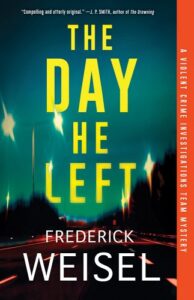When I celebrated the publication of my first novel, one of my friends briefly steered me away from the hubbub and toasts and quietly asked: “Now what do you want?” I don’t remember what I said in the moment, but the question later haunted me as I struggled to find a satisfactory answer. It had taken me years to write the book. What did I really want from all that dreaming and effort?
Sales? Of course, but I was under no misconception that my little mystery would be a bestseller or make me rich. A fellow author once told me, whatever the number of books you sell, it’ll never be enough.
What else did I want? Good reviews? Sure, and I got them, but that wasn’t the point. Awards? No. Like many fiction writers, I’m delusional, just not to that extent.
Eventually, I realized the question is really about why we write fiction. We write for a hundred reasons: to tell a good story, to take the viewpoint of someone rarely heard, to expand the concept of the novel, maybe even to say something original about the human condition. But, whatever our aim, unless we’re monks, there’s another common objective. We write to reach others. My own answer finally came down to something like this: I wanted a few people—not in my immediate family—to read my book and talk about what the story meant to them. Maybe I wanted this because I’d once been a literature student who took it all seriously; who sat around a table arguing about Dickens and James, Austen and Woolf; and who once spent a year writing a thesis titled “Debt and Speculation in the Nineteenth-Century Novel.”
The thing I wanted also arose from a broader reason. Both my novels were published during the strange time of COVID, when all public gatherings were cancelled and all launches were online. I’m very grateful for the virtual launches, which allowed me to meet an audience around the country who I would otherwise never meet. Still those events lacked something in not being in-person.
In today’s world, what I wanted turns out to be a book club. And in the end I achieved that goal by accident. A few months after my second novel was published, and after the pandemic had eased, a local book fair offered me a table to sell my books, along with thirty or so other authors. As I sat behind my table, a woman approached, bought copies of both novels, and told me she was recommending them to her book club. My wife, who I thought had come with me strictly for moral support, then announced, “If you like, he’ll come speak to your club.” This idea had not, in fact, occurred to me. But when I saw the woman’s look of happiness, I could hardly not follow through.
After that, through word of mouth and happenstance, I was invited to other book clubs. While getting my hair cut, I mentioned a recent book club experience. A woman in the waiting room overheard me, ordered my book on her phone, and texted me an invitation to her club.
So what did I learn? More than I thought.
For an invited author, book clubs are not salons. The club members I met did not aspire to be Gertrude Stein or Virginia Woolf. They were, refreshingly, people from different backgrounds and life experience talking about their personal take on a piece of writing. The result was the meetings put me in touch with readers in a more direct way than launches, panels, and signings.
People still read. Okay this one sounds obvious, but it remains something of a marvel to me. We live in a time of entertainment abundance: every three or four minutes, one of the streaming services releases a new 10-episode, must-see series. Listening to podcasts and keeping up with social media can eat up hours. In the face of this, in my case, book club members committed to reading 90,000 words. As Coleridge described it, they “willingly suspended disbelief” and embraced a wholly invented story and cast of characters. This sacrifice harkens to the first of Kurt Vonnegut’s famous “Eight Rules of Storytelling”: “Use the time of a total stranger in such a way that he or she will not feel the time was wasted.”
Readers like hearing stories of the writing process. This may be part of that human impulse to learn how things are made, as attested by the popularity of cooking shows. I know many authors tire of this subject and find it self-indulgent, beside the point, and a distraction from the work itself. But, as the author of just two novels, I’m not that tired yet. Book club audiences enjoyed hearing and asking questions about the face on a magazine cover who became the killer in my first novel, the news article that was the spark for my second book, the research query that was unexpectedly answered, and my misreading of a Louise Penny novel that inspired me to write a pivotal dialog between two characters. Club members appreciated the behind-the-scene stories of where the titles came from, how the cover was designed, a rejected cover design, and the definition of a blurb and how they’re collected.
I learned that as a novelist, I unintentionally created problems for readers. One club member told me my first novel has 109 character names, which I myself had never counted. To keep them straight, she’d written all the names in the book’s flyleaf and inside back cover.
Not everyone loves your book. In a book club, they tell you this to your face, not in the snarky, scoring-points way of a social media post, but in an honest explanation of what didn’t work for them. That explanation will, like nothing else, bring you back down from whatever pedestal you climbed up on and, even if you reject the criticism, might open your eyes to other ways of seeing the story.
Book club is not fight club. As portrayed in the 1999 David Fincher movie of the same name, fight club’s memorable first (and second!) rule is: “You do not talk about fight club.” Book club members talk about the club: how to make it better, which books they never finished, beloved books still remembered years later. Members of book clubs are less shy about speaking up than in bookstores or auditoriums, although I found some members are unsure of exactly what to say about a book. Book club readers also talk about how they read your novel. If you imagine someone reading your novel in a single sitting, that almost never happens. They read for a few hours and put it down for a week, then pick it up again. At which point they’ve lost track of the continuity.
Book clubs are typically of a modest size: ten or twelve people sitting in someone’s living room. As an author, it’s your audience writ small. It teaches you to not obsess over crowd size but to respect the individuals who show up.
I found book clubs very different from the cliché of their depictions in films and TV, where members get together under the pretense of a book club only to ignore the book, drink chardonnay, and gossip about their relationships. What struck me about the clubs I attended was how substantive and focused they were. Our age can sometimes seem one of minutiae—tweets, posts, reels, incomplete snatches of information, and a multiverse of rabbit holes. As informative as these media can be, and as perfectly suited to the present era, at times, it can feel as if our rebellion against narrative and long form has succeeded beyond all our hopes, that we’re spending too much time in the margins and footnotes and not enough on the main page. The book club discussions were squarely on the main page, in the meat of the book, the content of the stories, the issues raised.
I was also reminded of that special thing about the discussion of fiction. Reading novels and short stories is a deeply intimate and inventive act. We visualize and re-create the characters, the settings, the scenes. With the best fiction, the stories play out so clearly in our mind that we can see the streets and room interiors. We can even tell ourselves things about the characters, things not actually contained in the book. Sharing these visions in a book club discussion, in turn, is another personal and vulnerable experience.
Finally, I learned that—while imperfect, old-fashioned, anachronistic, and probably doomed— book clubs are something rare in the world of writing and publishing. They are not royalty checks or BookScan graphs, which are—let’s face it—about buyers, not necessarily readers. They are not viral social media, which can reach people half a world away but can also be a platform for bad behavior rarely tolerated in person in a living room. Unlike bookstore Q&As, which are largely one-sided, book clubs are conversations, with readers talking as much or more than a visiting author. They are the literal experience of your book being read. They are an answer to that voice going out into the world. They are some of the best voices coming back.
***


















